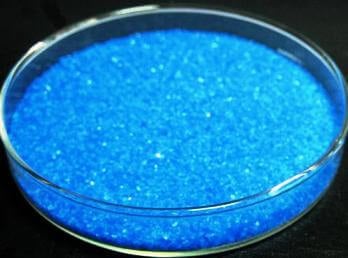Organic farming uses pesticides just as conventional farming does. The only difference is that the pesticides used in organic agriculture have to be derived from “natural” sources. One such example is copper sulfate, which is used in temperate climes as a fungicide. Many anti-GMO activists have pointed to pesticides used in conventional agriculture, such as glyphosate, and 2,4-D, as dangerous to people, animals, and the environment. For example, anti-GMO organization, The Environmental Working Group, says this about 2,4-D:
Researchers have linked 2,4-D to hypothyroidism, suppressed immune function, Parkinson’s disease, cancer and other serious disorders. Farmworkers could inhale 2,4-D and get it on their skin while spraying it. The chemical could drift from sprayed fields into nearby neighborhoods. People would track it into their homes. The damage can reach beyond the farmers who live close to sprayed areas.
The International Agency for Research on Cancer (IARC), the cancer research arm of WHO, declared the popular synthetic pesticide glyphosate “probably carcinogenic to humans”. A ruling that is often used my organic activists to argue that glyphosate (and glyphosate resistant GE crops) should be eliminated from use.
Many activists organizations try to tie organic farming to pesticide free farming and conventional (both GMO and non-GMO) to heavy pesticide use. The result is that many consumers have false perceptions about organic and conventionally grown foods. The Soils Association in the UK published poll results that showed 95 percent of consumers said they buy organic food because they believe they are avoiding all pesticides.

While no pesticide is entirely safe, organic products are not necessarily less hazardous than their conventional counterparts. Nor are they pesticide free. Copper sulfate is one of many pesticides approved under the USDA National Organic Program and a number of studies show that it has a great deal of toxicity to both humans and the environment. For example it is toxic to honeybees when used as a fungicide and a study showed extreme toxicity to bees in tropical environments(it was carried out in Brazil), where copper sulfate is used as a sprayed fertilizer (to provide heavy metal nutrients). In addition, some wineries in France, the United States and elsewhere have backed away from growing organic wine because of accumulation of copper in the soil.
What does copper sulfate do?

Copper sulfate is one copper atom bound to one sulfur and four oxygen atoms (the sulfur and four oxygens make the “sulfate” part). It has been registered for use in the United States since 1956. Copper sulfate works because the copper atom binds to proteins, altering the structure of those proteins. This can disrupt the membranes around cells, causing the cells to die. Copper sulfate is effective at killing fungi, algae, and even snails in this way.
In conventional agriculture as well as organic, it can be used as a fungicide. In organic applications, it’s used a lot. According to the National Center for Food and Agricultural Policy, copper, one of the top two organic fungicides (sulfur’s the other one), was used at a rate of 4 pounds per acre in 1971. In contrast, synthetic fungicides used on conventionally grown crops only required a rate of 1.6 lbs per acre.
It’s also used in non-agricultural applications, such as killing algae in swimming pools and even keeping algal populations down in natural lakes. And, like many other pesticides, some fungi and algae have developed a resistance to it, a characteristic that’s been known for nearly 60 years.
Copper sulfate also presents health hazards to humans and larger animals since its actions are not specific to just fungi. It has been associated with skin and eye irritation, and swallowing large volumes of it can cause nausea, vomiting and tissue damage. It has not been associated with cancer, but its long-term exposure effects are unknown.
Its manufacture is also done in a factory. There are several US patents that apply to making copper sulfate, which is usually done by combining other forms of copper (in this case, copper carbonate) with sulfuric acid and water in a commercial reactor, which is then ultimately centrifuged to create the final product. The largest manufacturer of copper sulfate is a company named Old Bridge Chemicals, based in New Jersey.
While much attention has been focused on glyphosate, 2,4-D and other conventional chemicals (which also are used on genetically modified crops), it’s important to understand what’s being used on organic fields, as well. Many of the criticism of synthetic pesticides can also be applied copper sulfate, but this doesn’t mean we should drop pesticides—organic and synthetic—altogether. The ways in which farmers use these beneficial crop protection agents are both safe for farmers and consumers, and they also provide major economic benefits to both groups too.
Andrew Porterfield is a writer, editor and communications consultant for academic institutions, companies and non-profits in the life sciences. He is based in Camarillo, California. Follow @AMPorterfield on Twitter.































